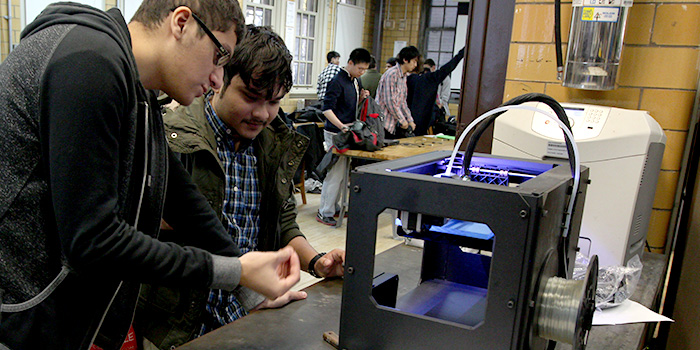“At the global scale, numerous universities (e.g. MIT) have already integrated 3D printing classes in their curricula,” the researchers state. “In Austria, some universities (e.g. AAU Klagenfurt, TU Graz) run 3D printing labs. Comprehensive 3D printing education at the high school level is crucial to enable the timely development of required skillsets, yet 3D printing is still novel at the high school level.”
In the study, the researchers used the previously developed Unified Theory of Acceptance and Use of Technology (UTAUT) model of investigation as a basic to develop their own research model. UTAUT proposes three direct predictors: performance expectancy, effort expectancy, and social influence of an individual’s behavioral intention to use technology. The researchers set up a project called “SmartLab Goes to School,” in which high school were invited to present innovative ideas for using 3D printing technology for the chance to win a 3D printer for classroom use.
A questionnaire was distributed among Austrian teachers, resulting in a sample size of 103 respondents. 84 teachers stated that they had experienced 3D printing technology, while 19 replied that they had no experience with it. Unsurprisingly, teachers who taught technical subjects were found to have stronger inclinations to teach 3D printing technology than teachers of more academic or business education subjects. Interestingly, teachers with no 3D printing experience had stronger inclinations to use 3D printing, suggesting that many teachers who have used the technology have had negative experiences with it in the past.
Several of the researchers’ hypotheses were supported, including:
- Teachers with high levels of performance expectancy are more likely to have a stronger intention to use 3D printing technology
- Teachers with high levels of anxiety are less likely to have a stronger intention to use 3D printing technology
- Teachers with a positive attitude towards using 3D printing technology are more likely to have a stronger intention to use 3D printing technology
- Teachers who perceive facilitating conditions positively are more likely to have a stronger intention to use 3D printing technology
Anxiety was a significant factor in the hesitancy of some teachers to use 3D printing – anxiety about making uncorrectable mistakes, for example, or apprehension about technology in general. Teachers were positively influenced toward using the technology by knowledge about its benefits, as well as the feeling that they had the proper resources, knowledge and support. Thus, the researchers conclude that the introduction of technology into classrooms is not just a financial or technical issue, but depends on the level of support teachers are provided.“The main goal to contribute to a better understanding of teacher acceptance of novel technology and their intention to use it was thus achieved,” the researchers state. “The findings provide evidence that there is a strong intention among teachers to use novel technology. Further, we demonstrate which personal and environment-related factors affect novel technology adoption.”
Authors of the paper include Patrick Holzmann, Erich J. Schwarz, and David B. Audretsch.
Discuss this and other 3D printing topics at 3DPrintBoard.com or share your thoughts below.
Subscribe to Our Email Newsletter
Stay up-to-date on all the latest news from the 3D printing industry and receive information and offers from third party vendors.
Print Services
Upload your 3D Models and get them printed quickly and efficiently.
You May Also Like
The Market and Industry Potential of Multi-Material 3D and 4D Printing in Additive Electronics
Additive manufacturing leverages computer-based software to create components for products by depositing either dielectric or conductive materials, layer by layer, into different geometric shapes. Since its birth in the 1980s,...
3DPOD 262: Bio-inspired Design for AM with Dhruv Bhate, Arizona State University
Dhruv Bhate is an associate professor at Arizona State University. There, he looks at structures, materials, and design. Previously, he worked at PADT as well as in the semiconductor and...
3DPOD 261: Tooling and Cooling for AM with Jason Murphy, NXC MFG
Jason Murphy´s NXC MFG (Next Chapter Manufacturing) is not a generalist service; instead, the company specializes in making tooling. Using LPBF and binder jet, the company produces some of the...
3DPOD 260: John Hart on VulcanForms, MIT, Desktop Metal and More
John Hart is a Professor at MIT; he´s also the director of the Laboratory for Manufacturing and Productivity as well as the director of the Center for Advanced Production Technologies....



































